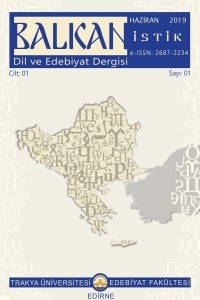BULGAR EDEBİYATINDAKİ İLK İSTANBUL SEYAHATNAMESİ ÜZERİNE BAZI GÖZLEMLER
Yüzyıllar boyunca İstanbul; Bulgar siyasi, askerî ve manevi tarihinde tayin edici rol oynamıştır. Günümüzde de her Bulgar, Boğaz kıyısındaki eşsiz şehri kendine çok yakın bulur. Ancak Bulgar edebiyatında İstanbul’u odağına alan ilk seyahatname, oldukça geç, 19. yüzyıl sonlarında kaleme alınır. Bu gecikmenin açıklanabilmesi için Bulgar’ın içindeki seyyahın, Bulgar toplumunun kaçınılmaz sancılar beraberinde modern hayata eklemlenmeye çabaladığı 1890’larda ortaya çıktığının göz önünde bulundurulması gerekir. Daha önceki yıllarda yazılan ve seyahatname türünün başlıca ögelerini barındıran eserlerde yerel coğrafyanın kapsandığı, Osmanlı İmparatorluğu sınırlarının dışına çıkılmadığı görülür.
Bu çalışmada payitahtın Bulgar tarihindeki yeri, ünlü şair ve gazeteci Petko Slaveykov’un İstanbul tasviri (1866) ve ilk doktoralı Bulgar hekim olan Dimitır Mollov’un bir dergide yayınladığı İstanbul izlenimleri (1888) hakkında kısaca bilgi verildikten sonra Bulgar edebiyatında ilk İstanbul seyahatnamesinin yazarı olan Todor Yankov’un hayat hikâyesi ve anılan eserle ilgili bazı gözlemler üzerinde durulmaktadır. Avrupalı bir seyyah yaklaşımı içinde şehrin sadece parıltılı yerlerini ve mekânlarını gezmekle yetinmeyen yazar, İstanbul’un eğri sokaklarına iner, caddelerde sokak köpekleri ve faytonlar arasında yürür, çarşılarda dolaşır, kahvehanede Türk kahvesi yudumlar, tekkede müridin tutkusuna ortak olur. Todor Yankov’un sıradan insana ve tekdüze akan hayatı canlandırmaya yönelik çabası, seyahatnameye ayrı değer katar ve özgünlük kazandırır. Kadim şehirde yalnızca Bulgar millî ve manevi tarihinin iz düşümleriyle ilgilenmemesi ise Avrupa değerlerini benimsemiş, farklı dünya görüşüne sahip bir kuşağı temsil etmesiyle açıklanabilir.
Anahtar Kelimeler:
Bulgar Edebiyatı, İstanbul, Seyahatname, Petko Slaveykov, Dimitır Mollov, Todor Yankov
SOME OBSERVATIONS ON THE FIRST TRAVEL TO ISTANBUL IN BULGARIAN LITERATURE
For centuries, Istanbul has played a decisive role in Bulgarian political, military and spiritual history. Today, every Bulgarian finds the unique city on the Bosphorus very close to himself. However, the first travel book focusing on Istanbul in Bulgarian literature was written quite late, at the end of the 19th century. In order to explain this delay, it should be taken into account that the traveler in Bulgaria emerged in the 1890s, when the Bulgarian society tried to articulate with modern life with inevitable pains. In the works written in previous years and containing the main elements of the travel book, it is seen that the local geography is covered and the borders of the Ottoman Empire are not exceeded.
In this study, after giving brief information about the place of the capital in Bulgarian history, the description of Istanbul by the famous poet and journalist Petko Slaveykov (1866) and the impressions of Istanbul (1888) published in a journal by the first Bulgarian physician with a doctorate, Dimitir Mollov, who is the author of the first Istanbul travel book in Bulgarian literature, are mentioned. The life story of Todor Yankov and some observations about the mentioned work are emphasized. The author, who is not content with only visiting the glittering places and places of the city with a European traveler's approach, descends to the curved streets of Istanbul, walks among the stray dogs and phaetons on the streets, wanders in the bazaars, sips Turkish coffee in the coffeehouse, and shares the passion of the disciple in the lodge. Todor Yankov's effort to revive the ordinary person and the monotonous life adds a special value and originality to the travelogue. The fact that the ancient city is not only concerned with the projections of the Bulgarian national and spiritual history can be explained by the fact that it represents a generation that has adopted European values and has a different worldview.
Keywords:
Bulgarian Literature, Istanbul, Travelogue, Petko Slaveykov, Dimitir Mollov, Todor Yankov,
___
- BORSHUKOV, Georgi (1976), İstoriya na bǎlgarskata jurnalistika (1844-1877, 1878-1885), Sofya: Nauka i izkustvo.
- İGOV, Svetlozar (1996), Kratka istoriya na bǎlgarskata literatura, Sofya: Prosveta.
- MEVSİM, Hüseyin (2015), “Dimitır Mollov’un Edirne Anıları”, Yöre, 163, Edirne.
- MEVSİM, Hüseyin (2019), “İstanbul – Sığınak ve Yurt”, Atlas, 311, İstanbul.
- MEVSİM, Hüseyin (2022), “Sunuş”, Yankov, Todor. İstanbul’dan İzlenimler. 19. Yüzyıl Sonlarında Şehir, İstanbul: Kitap Yayınevi, 7-13.
- MOLLOV, Dimitır (1888), “Pǎtni belejki,” Periodichesko spisanie na Bǎlgarskoto knijovno drujestvo, 25/26, Sofya.
- MOLLOV, Dimitır (2022), “Yolculuk Notları,” Hüseyin Mevsim (Çev.), Yankov, Todor. İstanbul’dan İzlenimler. 19. Yüzyıl Sonlarında Şehir, İstanbul: Kitap Yayınevi, 60-76.
- SLAVEYKOV, Petko (1982), “Tsarigrad”, Pǎtishta i pǎteshestvenitsi, XIV-XIX vek, Svetla Gyurova (Der.), Sofya: Bǎlgarski pisatel, 182-195.
- SLAVEYKOV, Petko (2000), Poeziya i publitsistika, Veliko Tǎrnovo: Slovo.
- TOPALOV, Kiril (1983), Problemi na bǎlgarskata vǎzrojdenska literatura, Sofya: Nauka i izkustvo.
- YANKOV, Todor (1898), “Vpechatleniya ot Tsarigrad,” İlyustratsiya “Svetlina”, IV, V-VI, VII, IX, Sofya.
- YANKOV, Todor (1939), Pǎtepisi, I, Sofya: Voenno-izdatelski kompleks.
- YANKOV, Todor (1939), Pǎtepisi, III, Sofya: Voenno-izdatelski kompleks.
- YANKOV, Todor (2022), İstanbul’dan İzlenimler. 19. Yüzyıl Sonlarında Şehir, Hüseyin Mevsim (Çev.), İstanbul: Kitap Yayınevi.
- Yayın Aralığı: Yılda 2 Sayı
- Başlangıç: 2019
- Yayıncı: Trakya Üniversitesi
Sayıdaki Diğer Makaleler
ÇAĞDAŞ YUNAN EDEBİYATINDA POLİSİYE TÜRDEKİ İLK ÖRNEKLERİN KISA BİR TARİHİ
TRAJİĞİN İRONİSİ: ÖLÜ ORDUNUN GENERALİ ÜZERİNE
17. YÜZYILA AİT ANONİM BİR TÜRKÇE-SIRPÇA HIRVATÇA SÖZLÜK
BULGAR EDEBİYATINDAKİ İLK İSTANBUL SEYAHATNAMESİ ÜZERİNE BAZI GÖZLEMLER
HATA ANALİZİ: TÜRKÇEDE İSMİN HÂLLERİ VE TÜRKÇE ÖĞRENEN ÖĞRENCİLERİN BU KONUDA YAPTIĞI HATALAR
